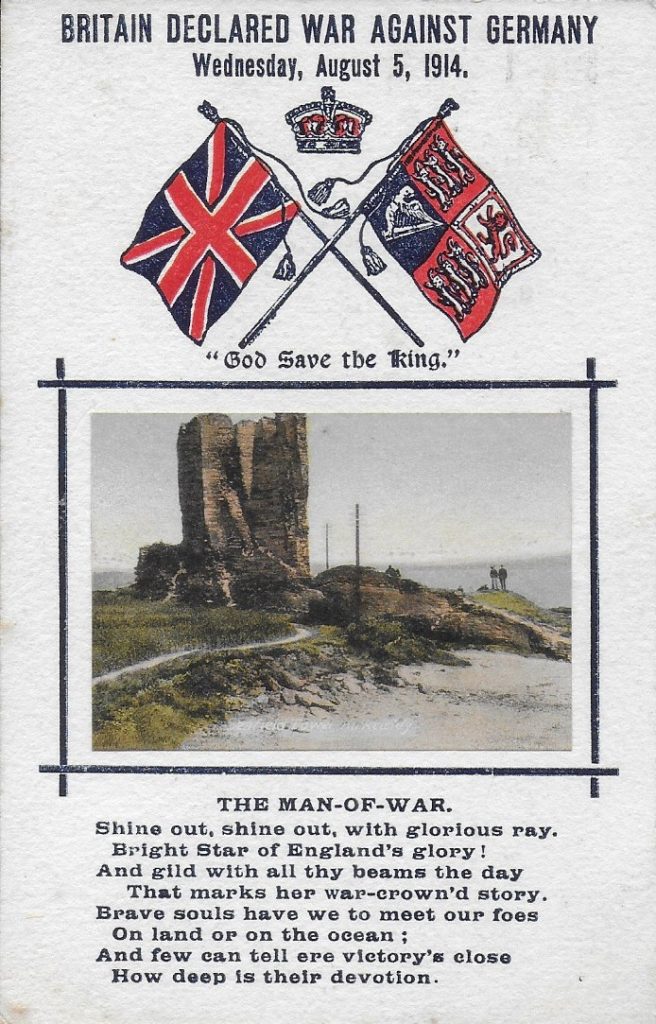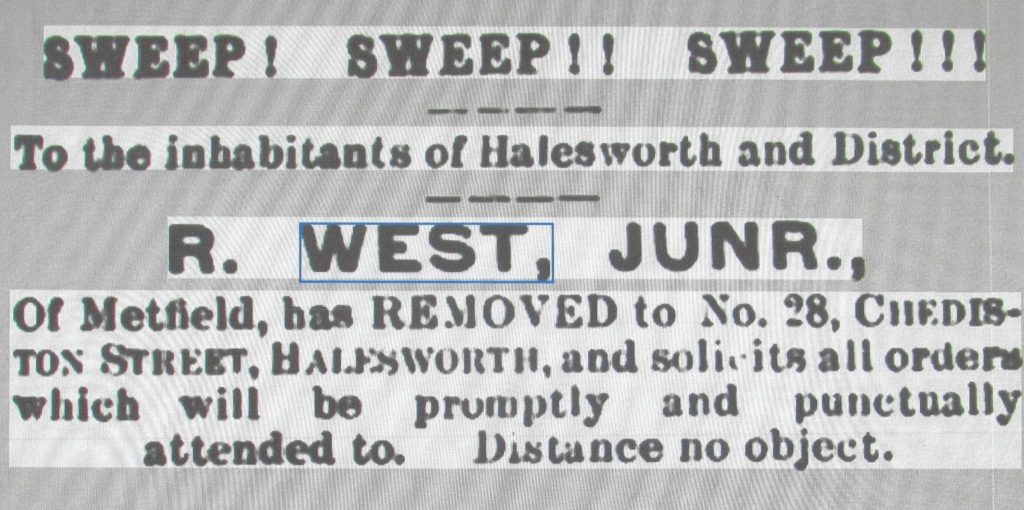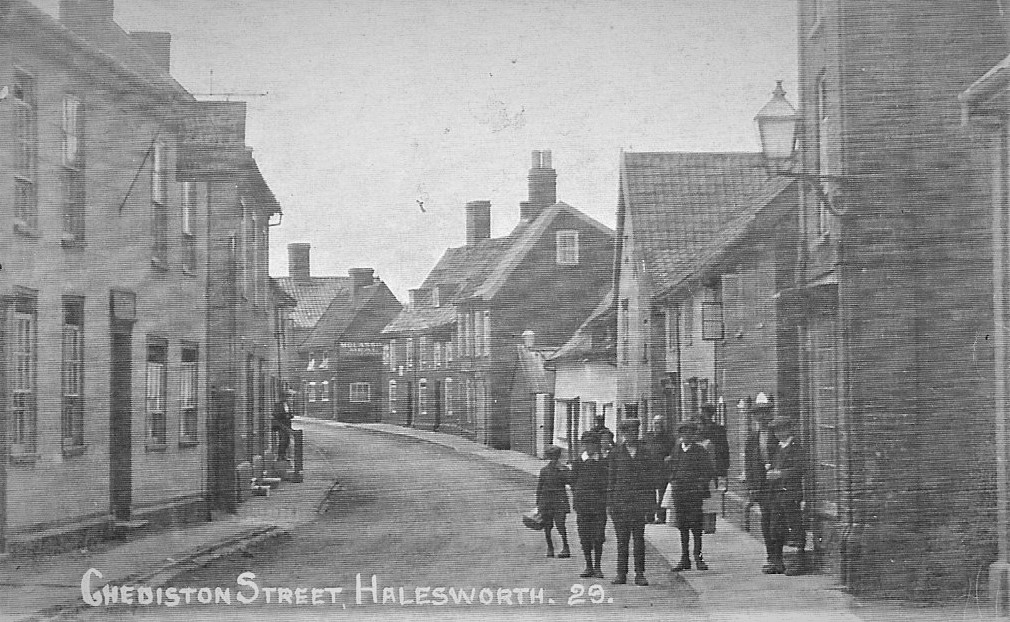6100 LANCE CORPORAL ROBERT GEORGE WEST
1ST BATTALION NORFOLK REGIMENT
KILLED IN ACTION
14TH SEPTEMBER 1915
AGE 32 YEARS
George Robert West (to give him the name that he was baptized with at St Peter and St Paul’s parish church in the village of Brockdish, Norfolk on 3rd January 1886) was born three years earlier on 25th October 1883, the first child of Robert, a chimney sweep, and Mary (née Marjoram). By the time of the 1891 census he was listed as Robert George, with his Christian names having been reversed. This is how he would be known for the rest of his life. Ten years later, at the time of the 1901 census, the family, including Robert, had moved across the county border and were now to be found living in the Suffolk village of Metfield, where Robert senior continued to ply his trade, now with young Robert employed as his father’s assistant. It would appear that the life of a sweep did not appeal to Robert junior for long as, on 4th March 1902, he had travelled to Norwich, the county town of Norfolk, to enlist in the army. His surviving records show that, after passing the various tests and medical examination, he was enlisted to serve as a Private soldier in the Norfolk Regiment with the service number of 6100. He then signed his original contract to serve for seven years with ‘The Colours’ and five on the reserve list. Although some twenty pages of Robert’s military records recording his pre-war and World War One service have survived, much of the information recorded on them is very difficult to read, due to both fire and water damage, caused when the Paddington repository where these records were stored, suffered heavy damage during the London Blitz in World War Two. From what remains legible, it can be seen that, after completing his training, he then spent the initial period of his service with the 2nd Battalion Norfolk Regiment in England. By September 1904 he had been sent out to India to join the 1st Norfolks, where he remained for the next four or so years. In March 1906 Robert received a temporary posting to serve with the 33rd Company of the Army Service Corps before returning to his battalion. In May 1909, after having extended his overseas service by a further year, he began the long journey back to England via Gibraltar where he remained for several weeks with the 2nd Norfolks. Following this, he completed his journey to Aldershot in Hampshire, to be released from regular service, being transferred to the reserve on 2nd March 1910. On his return to the family home in Saint James Road, Metfield he took up his old trade as a chimney sweep. At some time over the following few years he met and courted a young lady by the name of Emily Potkins, whom he married at the Withersdale Street parish church on 1st October 1913. During the earlier months of that year and prior to his wedding, Robert must have decided to branch out on his own, by moving from Metfield to set himself up in his own chimney-sweeping business in Halesworth. After finding a property at 28 Chediston Street, he placed an advertisement in the town’s newspaper on 8th April 1913. (see below)
On 2nd January 1914, shortly before the completion of his original term of reserve military service, which had been due to expire on 4th August 1914, Robert travelled to Norwich to transfer what remained of his statutory period with the reserves to become a member of the 3rd (Reserve) Battalion of the Norfolk Regiment, then permanently based at Britannia Barracks in Norwich.
At the beginning of August, with the threat of the outbreak of war ever more likely, Robert, with many other Norfolk reservists, rushed to re-enlist in their old regiment. On 5th August 1914 Great Britain declared war against the Kaiser’s Germany after their troops marched into neutral Belgium. At this time the 1st Battalion Norfolk Regiment were based in Palace Barracks on the outskirts of Belfast, while the Regiments 2nd Battalion were to be found serving in India. Within a very short period of time, units of the Regular Army were crossing to France to form the British Expeditionary Force (B.E.F.). With further distance to travel than most of the regiments serving on the mainland, the 1st Norfolks, as part of the 5th Division, landed at the French port of Le Havre on 16th August 1914. Once complete they crossed the French border and advanced into Belgium to take on the ‘Hun’. While the 1st Norfolks were involved in their first battles of the war, back in Norwich George was one of several returned reservists to be medically examined and re-equipped with new uniforms and equipment in preparation for their return to the 1st Battalion. On 26th August, with a large party of other reinforcements, he crossed to France where they were initially held in reserve. In the meantime the B.E.F., with their French and Belgium comrades, had suffered a series of defeats which saw many of their regiments retreat back across the French border. By 9th September the 1st Norfolks, having suffered over two hundred and fifty casualties, had been pulled out of the frontline and were regrouping in the area of Nampteuil. It would have been here that George and several other Norfolk reservists joined the battalion as casualty replacements. As the winter months of 1914 began to close in on the Continent the open warfare between the adversaries, with a few exceptions, gradually settled down to a period of static engagements with each side beginning to dig defensive positions that would eventually stretch from the French coast to the border of Switzerland. This then developed into what would become four long years of trench warfare. As the war dragged on, with more and more of the 1st Norfolks’ pre-war regular soldiers becoming casualties, the ranks of the battalion were filled with new recruits from the Depot, so that any of the remaining regulars or their reservists who had previous experience were considered for promotion. It was on 18th June 1915 that George, the eternal Private soldier, having now served some thirteen years in both the army and its reserves, received his first promotion to the rank of Lance Corporal. The 1st Norfolks’ war diary for the days prior to George’s reported death on 14th September 1915, show that for the first ten days of the month they were holding a section of the front line in the area of Maricourt in the Somme region of France. On being relieved during the early hours of 11th September by the 1st East Surreys, they then marched back to billets at Molancourt. Here the men would have received a rest period with time to clean themselves and their equipment, while the Officers would have carried out any matters of administration that related to their companies. It would also have been the time that the battalion’s Adjutant, who probably held the rank of Captain, would have written up the Battalion War Diary for the ten day period that they had recently spent in the line from 1st to 10th September. Reading this, courtesy of Ancestry.com, we learn that, during that time, they had suffered one man killed with another man wounded, with no further fatal casualties reported over the following days. It is therefore possible that George had in fact died prior to the date registered by the Adjutant on 14th September, the day that he had written his notes. After his loss George was buried by his comrades in the local village cemetery, where he remained the only British casualty until 1926 when the Commonwealth War Graves Commission had his body exhumed. He was finally laid to rest in the Morlancourt British Cemetery No.1, in France.
A note on one of George’s record sheets shows that his widow Emily was notified of his death on 25th September 1915, with her receiving the first payment of the War Gratuity, exactly two months later. This, combined with the second payment made in August 1919, amounted to a total of £14.4s.4d (£14.22p). Also from 27th March 1916 she was awarded a pension for her loss of 10s.0d (50p) per week. This, for some unknown reason, was suspended on 23rd October 1916 with a note on the payment form that stated ‘Widow Unworthy’, which at that time had a number of unpleasant definitions. The pension was then transferred to George’s mother, Mrs Mary West.
In addition to the financial awards arising from George having lost his life, his nominated next of kin would also have been entitled to claim his medal awards of the 1914 Star bar trio with his named bronze memorial plaque and scroll.
On 23rd December 1921 his widow signed a receipt for the British War and Victory medal pair. The location of these and the remainder of his awards is not known.
Above is a copy of a postcard of the infamous Chediston Street dated around 1912. It had been shortly after its publication that Robert had moved in to number 28 to set up his Chimney Sweep business.



